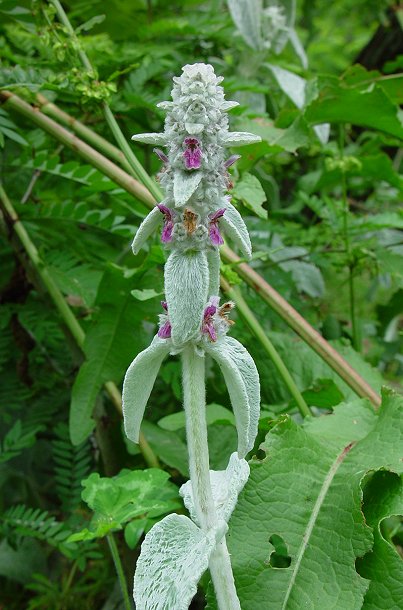Stachys byzantina K. Koch
Woolly Hedgenettle

Introduced
CC = n/a
CW =
MOC = 0
© DETenaglia
Stachys byzantina K. KochWoolly Hedgenettle | |
 |
Introduced CC = n/a CW = MOC = 0 |
© DETenaglia |
|
Family - Lamiaceae Stems - To 50cm tall, multiple from base, erect to ascending, herbaceous, branching, 4-angled. Entire plant covered with very dense grey lanate pubescence.
Leaves - Opposite, decussate, petiolate below to subsessile above. Petiole to +8cm long. Blade elliptic to lanceolate, to +15cm long, +6cm broad, acute, tapering to base, crenate, margins slightly sinuous.
Inflorescence - Terminal dense spikiform arrangement of verticillasters. Flowers sessile, subtended by reduced leaves(foliaceous bracts).
Flowers - Corolla purple with some mottling internally, bilabiate. Corolla tube 7-8mm long, pubescent externally. Upper lip single, shallowly 3-lobed to entire at apex, 5mm long, 4-5mm broad. Lower lip 3-lobed. Two lateral lobes shallow, much smaller than central lobe. Central lobe 6-8mm long, 5mm broad. Stamens 4, didynamous, slightly exserted from upper lip of corolla. Filaments adnate at apex of corolla tube, dense pubescent, purple. Anthers purple, 1.1mm broad. Style 8mm long, glabrous, white to lilac, slightly exserted. Stigma 2-lobed. Ovary of 4 nutlets. Calyx tube to 8mm long, 5-lobed. Lobes subequal, acute, acuminate, to 2.5mm long, 2mm broad at base.
Flowering - July - September. Habitat - Cultivated and persisting around old homesites and vacant lots. Origin - Native to Eurasia. Other info. - This is an attractive perennial plant which is cultivated in our area. It is not officially recorded as escaped in our area but there are persistent patches of the plant in the Ozarks which are doing quite well. The soft pubescence and striking flowers make it an interesting garden plant. The flowers are also much liked by flying insects. Propagation is by division. The plant prefers full sun which is obvious from the protective layer of pubescence covering the entire plant. Photographs taken off Hwy 106, Shannon County, MO., 6-6-03. |